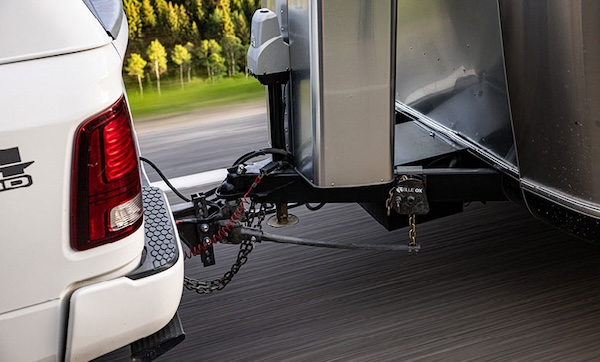Maintaining Sway Control 101
Help customers understand the risk sway presents, how to prevent it and why it matters.

One of the biggest concerns of RV owners is sway control. Whether they are driving a lightweight trailer, a toy hauler or even a small passenger vehicle, sway control and prevention is top of mind for novice and experienced drivers alike.
As Kevin Molland, director of marketing at Blue Ox, explains, sway control and prevention are paramount for ensuring the safety and stability of any towing setup. These systems are designed to maintain the alignment of a trailer with the towing vehicle, preventing the hazardous swaying that can lead to serious accidents, especially in high winds, on uneven roads or when overtaking large vehicles.

“By mitigating trailer sway, sway control hitches and devices can provide a smoother ride, enhancing the overall stability and control for the driver,” Molland says. “Additionally, reducing sway minimizes the excessive strain on both the towing vehicle and the trailer, leading to less wear and tear and prolonging the life span of a customer’s equipment. Thus, investing in quality sway control systems is not just a matter of comfort but a critical safety measure for all RV enthusiasts.”
Blue Ox’s parent company, Automatic Equipment Manufacturing, has been around since 1925. With the acquisition of Blue Ox in 1991, the company established a name for itself as a manufacturer of towing products, including weight-distributing hitches, sway control, tow bars and baseplates. Now both Automatic Equipment Manufacturing and Blue Ox are subsidiaries of Hesse Enterprises Company, with Blue Ox’s approach to towing being influenced by its heritage as a fourth-generation family-owned business.
“Embodying 99 years of craftsmanship on the family farm in Nebraska, where it all began, our robust towing equipment promises enduring reliability on the road,” Molland says. With such a long history, Blue Ox Towing has a wealth of experience dealing with sway prevention and control issues facing customers.
Sway & Different RV Types
So, from Blue Ox’s experience, what types of RVs present the greatest risk of sway issues? First, travel trailers are among the most common RVs that experience sway problems. According to Molland, a travel trailer’s boxy shape and high profile can catch more wind, and improper weight distribution can exacerbate sway.
“Also, lightweight trailers, which are often marketed for their ease of towing, can be more susceptible to sway due to their lighter weight,” Molland adds. “This can make them more reactive to crosswinds and passing vehicles.”
Toy haulers, which are designed to carry heavy loads like ATVs and motorcycles, can also experience sway issues. If the load is not balanced correctly, it can significantly increase the risk of sway.
“Compared to double-axle trailers, single-axle trailers are also generally less stable, making them more prone to swaying,” Molland says.
 And while the type of RV often dictates sway potential, so too do other factors, including improper loading and not knowing the gross vehicle weight rating (GVWR) of the towing vehicle and trailer, and other load-related factors.
And while the type of RV often dictates sway potential, so too do other factors, including improper loading and not knowing the gross vehicle weight rating (GVWR) of the towing vehicle and trailer, and other load-related factors.
As Molland explains, correctly loading an RV is crucial for stability; this involves distributing weight evenly, ensuring heavier items are placed low and centered, and avoiding excessive weight at the rear.
“Exceeding the GVWR of either the towing vehicle or the trailer can lead to instability and increased sway risk,” Molland says. Additionally, understanding the gross combined weight rating (GCWR), which includes the loaded vehicle’s and trailer’s total weight, is essential for safe towing. Regular maintenance of the towing equipment, including tires, brakes and hitch components, also plays a significant role in maintaining sway control and overall towing safety.
How Dealers Can Help
As such, RV dealers can play a vital role in helping their customers with sway control and prevention.
Molland recommends dealers explain the importance of an adequately matched towing vehicle and trailer, ensuring that the GVWR and GCWR are not exceeded. Dealers should also emphasize the significance of proper weight distribution, with heavier items placed low and centered, and dealers should caution against overloading the rear of the trailer.
“Also introduce the various sway control devices available, such as weight distribution hitches with integrated sway control, which helps maintain stability and reduce sway during travel. Additionally, advise customers to regularly check and maintain their towing equipment, including tires, brakes and hitch components, to ensure safe and stable towing experiences,” Molland says.
It is also imperative that dealers thoroughly explain the inherent dangers and potential risks involved when not having sway control.
“Without proper sway control, trailers are more susceptible to dangerous swaying, especially in high winds, on uneven roads or when passing large vehicles,” Molland says. “This swaying can lead to a loss of control, increasing the likelihood of accidents.”
Additionally, persistent sway places excessive stress on both the towing vehicle and the trailer, leading to accelerated wear and tear and potentially costly repairs.
Identifying Solutions
When a customer brings forward sway control issues to a dealer, there are several solutions available to address the sway control and prevent any future mishaps, each designed to enhance the stability of a towing setup.
 Molland says these include friction sway control devices, which use friction pads to dampen sway, and sway prevention systems employing a hitch head working with spring bars that employs caster to constantly center the trailer to the tow vehicle while also distributing trailer weight more evenly. Additionally, weight distribution hitches with integrated sway control combine the benefits of distributing trailer weight more evenly with active sway control, offering a comprehensive solution. Electronic sway control systems are also available, which use sensors and automatic braking to correct sway in real time.
Molland says these include friction sway control devices, which use friction pads to dampen sway, and sway prevention systems employing a hitch head working with spring bars that employs caster to constantly center the trailer to the tow vehicle while also distributing trailer weight more evenly. Additionally, weight distribution hitches with integrated sway control combine the benefits of distributing trailer weight more evenly with active sway control, offering a comprehensive solution. Electronic sway control systems are also available, which use sensors and automatic braking to correct sway in real time.
Blue Ox’s SwayPro and TrackPro use a computer-designed hitch head that, in combination with the spring steel sway bars, provides caster similar to the steering in your car or pickup that automatically returns the vehicle to center when coming out of a turn. In this case, the trailer is automatically returned to the center of the tow vehicle when the trailer is pushed off center by wind or rough roads. SwayPro’s system uses a chain and rotating latch system. When utilized properly with spring bars, it augments the suspension of the tow vehicle, significantly reducing the noise caused by most friction hitches. TrackPro’s spring steel bars work with friction and steel brackets to eliminate sway.
“Blue Ox suggests [that] dealers need to emphasize that investing in sway control devices enhances safety by maintaining stability,” Molland says. “It also helps protect a consumer’s investment by reducing mechanical strain and extending the life span of their equipment.”



